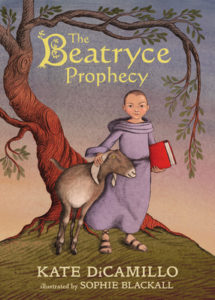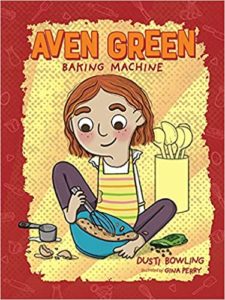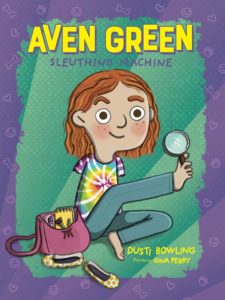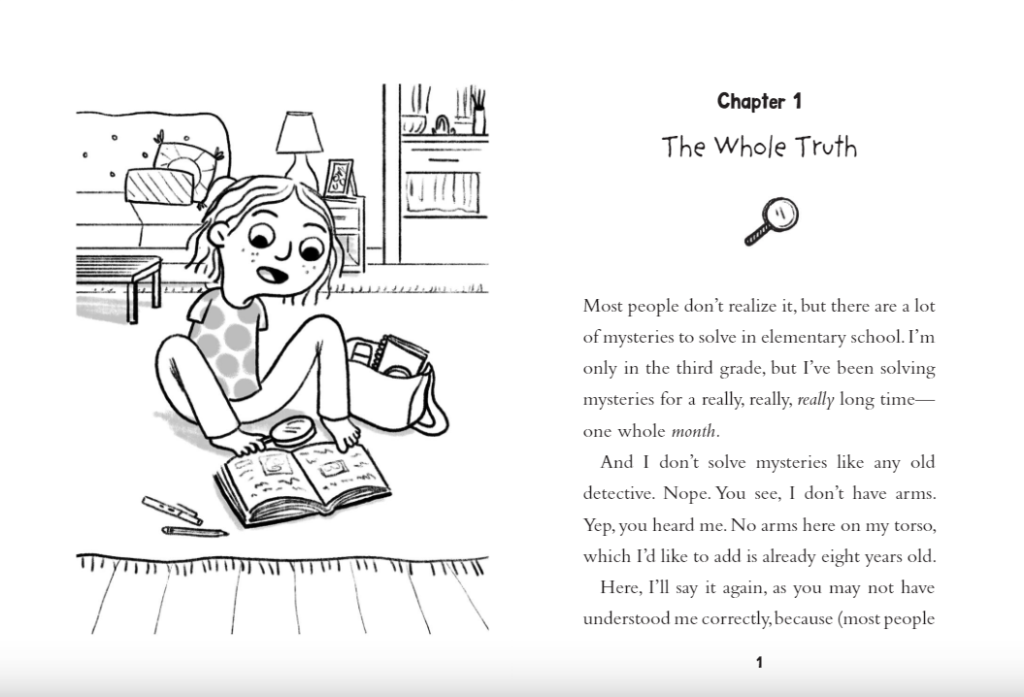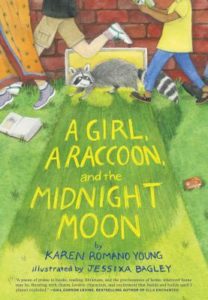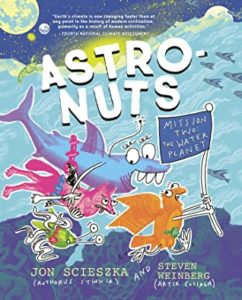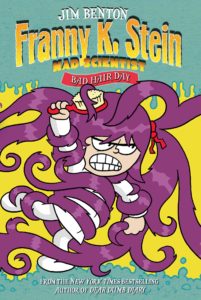“I Write About the Real World and Real Feelings… by Using Magic”
I like to say that I write about myself without writing about myself, that I try to understand my feelings by writing about someone else’s very similar feelings.
And I use magic to do it.
I have never owned a second hand shop filled with cuckoo clocks and birdcages and patchwork purses and chandelier earrings. I have never participated in an end of the school year parade, and, regrettably, I didn’t have a cousin who lived in the apartment downstairs from me when I was growing up. And most of all, as much as I wish I could, I have never witnessed magic. At least not the kind that shows up in my books. Not the magic passed down through generations, not the kind of magic that the best friend cousins of my HAND-ME-DOWN MAGIC series encounter in book after book.
But. I did have a best friend growing up, and we did it get into fights. I did have family that I sometimes felt part of and sometimes felt confused about my place in. I did feel jealous when a friend had something I wanted, and I did feel scared when things didn’t feel entirely in my control. Some of those things—fighting with a friend, feeling jealous or scared or left out or uncertain about who you are—are a little bit scary. Uncomfortable. Hard to talk about, and harder still to write a whole book or series of books about. When I am feeling those hard and scary and uncomfortable feelings, for myself or for my characters, I know it’s time for magic.
When something feels hard to look at straight on, I introduce a bit of magic to help make it easier to understand. Because there’s a lot about the world I don’t understand! There’s a lot about my characters’ worlds that I don’t understand right away. I don’t know when I first start writing why a particular bag in a particular shop window could make someone feel like they would become the best version of themselves if only they had it over their shoulder. And I don’t know why someone else’s happiness can sometimes feel like a personal slight. Or why it is hard to share in that happiness sometimes. I don’t even really know how to solve those problems, or any of the strange and awkward and tricky and uncomfortable problems that arise simply from being a person in the world interacting with other people. But I do know that many of us think we aren’t supposed to talk about those messier parts of our hearts and friendships and lives. And I do know that if I add magic, the conversation becomes easier.
I don’t try to hide the truth in my books—that doesn’t feel fair to anyone—me or my readers or the characters I spend so much time writing and falling in love with. But I try to make the truth easier to understand, easier to look at straight on, easier to manage. Magic helps manage hard truths—big ones, sure, but small ones too, little moments where your heart hurts or you are blushing and wish you weren’t, or your best friend is making you mad or sad or uncomfortable and you don’t know why. Look! Look at me! Magic says in those hard moments in my books, I’m here too! Maybe I can help? Maybe I can explain it? Or maybe I just make things a little lighter, a little prettier, a little more interesting than regular old life is.
Sometimes, I use magic to make a feeling bigger: what if Alma feels a little left out of her family life, not just because she hasn’t lived in the same home as them ever before, but also because the rest of them have a belief in magic that she just can’t seem to muster?
It’s an added layer to bulk up the feelings I want to discuss. A way to turn up the volume on the circumstances, so make sure they come through loud and clear.
Sometimes, I use magic to make the feeling easier: Someone I loved did something mean to me: maybe it was because of magic?
Mostly I use magic to make things easier to talk about: Life is confusing and big and hard to understand and not in our control and that is scary. But Del doesn’t want to say all of that. Or even think it. Del is scared of a crystal ball telling fortunes that come true in tricky ways. Let’s talk about that, and maybe it will show us some other things along the way.
Magic is sneaky. Maybe when we talk about Del’s fear of her crystal ball, we can start talking about other things that happen unexpectedly or other times we think something bad might be our fault. Magic lets a conversation evolve naturally, instead of going right to the center of things. Magic is a beautiful and fun and silly and shiny way in to the scary things.
It is easier to talk about the world—a world which is sometimes very challenging and uncomfortable and sometimes even a bit sad and lonely, especially lately—when there is a mix of the familiar and the mysterious. A mix of real life and magic. A combination of the things we understand and the things we never fully will. Magic, when done well, is the bridge between those two things.
Using a bit of magic to talk about the real world reminds me of an old fashioned radio dial. Magic can turn things up or down, it can cut through the static, it can help you search for the story you want to hear, it is a tool in the toolbox of a writer, and a reader, and a person in the world, when you are a bit lost and bit frightened and a bit unsure. I am those things pretty often. That’s why I use magic so much!
The truth is—I’m a writer and a reader and a parent and a person in the world, and I’m just as flummoxed as everyone else, about why things are the way they are or feel the way they feel. Magic helps me make sense of it all too, it gives me a little space and perspective, a new angle at which to look at my character’s circumstances. Which in turn helps me make sense of my own. I believe it can help make sense of things for young readers, too. Magic can bring order to the mess and can put a magnifying glass to the tiny tricky details. It can amplify what we need to look at more closely, a quiet what feels too scary to approach head on.
We all want to reach young people, we all want a way in. For me, magic is the way.
Maybe it can be for you too.
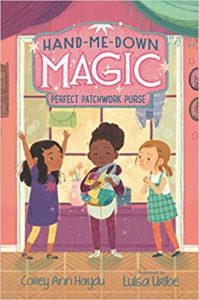
Hand-Me-Down Magic: Perfect Patchwork Purse
Author: Corey Ann Haydu
Illustrator: Luisa Uribe
Published May 4, 2021 by Katherine Tegen Books
About the Book: Family magic saves the day for best-friend-cousins Del and Alma in the third Hand-Me-Down Magic book! With adorable illustrations and short, easy-to-read chapters, this series is perfect for fans of Ivy & Bean and Dory Fantasmagory.
Almaknew it the first time she saw it: The patchwork purse in the window of the Curious Cousins Secondhand Shoppe was magical. Special. Perfect. But when her friend Cassie spots the purse and buys it, what could Alma do but agree that the purse really did look just right on Cassie?
Del decides it’s up to her to bring some homespun magic back into Alma’s life, and she’s got just the plan to do it. After all, she is the EXPERT on magic!
All she needs is some glitter and lots and lots of glue . . . because she knows magic can always come from the most unexpected places, but most importantly, that best-friend-cousins never let each other down.

About the Author: Corey Ann Haydu is the author of Eventown, The Someday Suitcase, and Rules for Stealing Stars and four acclaimed books for teens. She grew up in the Boston area, earned her MFA at the New School, and now lives in Brooklyn, New York, with her dog Oscar. Find out more at www.coreyannhaydu.com.
Thank you, Corey, for sharing how you use magic to tackle what is real!

